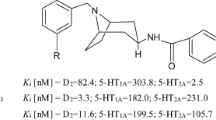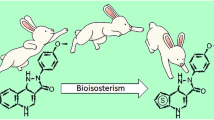Abstract
Design, synthesis and biological evaluation of B-region, known to be a dipolar interacting pharmacophore, modified diarylalkyl amide analogues for novel TRPV1 (transient receptor potential channel, vanilloid subfamily member 1) antagonists was described. A variety of moieties including guanidines, heterocyclic rings, cinnamides, and α-substituted acetamides were introduced at the B-region. TRPV1 antagonistic activities of these analogues were evaluated by 45Ca2+ uptake assay in rat DRG neuron. In particular, α,α-difluoroamide 53 exhibited 3-fold more potent TRPV1 antagonistic activity (IC50 = 0.058 μM) than the parent amide analogue 6.







Similar content being viewed by others
References
Banks, R.E., B.E. Smart, and J.C. Tatlow. 1994. Organofluorine chemistry: Principles and commercial applications. New York: Plenum Press.
Caterina, M.J., M.A. Schumacher, M. Tominaga, T.A. Rosen, J.D. Levine, and D. Julis. 1997. The capsaicin receptor: A heat-activated ion channel in the pain pathway. Nature 389: 816–824.
Doherty, E.M., C. Fotsch, Y. Bo, P. Chakrabarti, N. Chen, N. Gavva, N. Han, M.G. Kelly, J. Kincaid, L. Klionsky, Q. Liu, V.I. Ognayanov, R. Tamir, X. Wang, J. Zhu, M.H. Norman, and J.J.S. Treanor. 2005. Discovery of potent, orally available vanilloid receptor-1 antagonists. Structure-activity relationship of N-aryl cinnamides. Journal of Medicinal Chemistry 48: 71–90.
Gunthrope, M.J., and B.A. Chizh. 2009. Clinical development of TRPV1 antagonists: Targeting a pivotal point in the pain pathway. Drug Discovery Today 14: 56–67.
Hwang, S.W., H. Cho, J. Kwak, S.-Y. Lee, C.-J. Kang, J. Jung, S. Cho, K.H. Min, Y.-G. Suh, D. Kim, and U. Oh. 2000. Direct activation of capsaicin receptors by products of lipoxygenases: Endogenous capsaicin-like substances. Proceedings of the National Academy of Sciences of the United States of America 97: 6155–6160.
Kim, N.-J., F.-N. Li, J.H. Lee, S.G. Park, K. Kim, C. Lim, Y.T. Han, H. Yun, J.-W. Jung, H-g Park, H.-D. Kim, B.Y. Woo, S.S. Shin, S.-Y. Kim, J.K. Choi, Y.-S. Jeong, Y. Park, Y.-H. Park, D.-D. Kim, S. Choi, and Y.-G. Suh. 2013. Heterocycle-linked phenylbenzyl amides as novel TRPV1 antagonists and their TRPV1 binding modes: Constraint-induced enhancement of in vitro and In vivo activities. Chemistry—An Asian Journal 2: 400–409.
Kunishima, M., J. Morita, C. Kawachi, F. Iwasaki, K. Terao, and S. Tani. 1999. Esterification of carboxylic acids with alcohols by 4-(4,6-dimethoxy-1,3,5-triazin-2-yl)-4-methyl-morpholinium chloride (DMTMM). Synlett 10: 1255–1256.
Li, H., H. Shimizu, M. Flinspach, J. Jamal, W. Yang, M. Xian, T. Cai, E.Z. Wen, Q. Jia, P.G. Wang, and T.L. Poulos. 2002. The novel binding mode of N-alkyl-N′-hydroxyguanidine to neuronal nitric oxide synthase provides mechanistic insights into NO biosynthesis. Biochemistry 41: 13868–13875.
Li, F.N., N.J. Kim, S.M. Paek, D.Y. Kwon, K.H. Min, Y.S. Jeong, S.Y. Kim, Y.H. Park, H.D. Kim, H.G. Park, and Y.G. Suh. 2009. Design, synthesis, and biological evaluation of novel diarylalkyl amides as TRPV1 antagonists. Bioorganic and Medicinal Chemistry 17: 3557–3567.
Li, A.R., J. Zhang, J. Greenberg, T. Lee, and J. Liu. 2011. Discovery of non-glucoside SGLT2 inhibitors. Bioorganic and Medicinal Chemistry Letters 21: 2472–2475.
Lowe, R.F., J. Nelson, T.N. Dang, P.D. Crowe, A. Pahuja, J.R. McCarthy, D.E. Grigoriadis, P. Conlon, J. Saunders, C. Chen, T. Szabo, T.K. Chen, and H. Bozigian. 2005. Rational design, synthesis, and structure-activity relationships of aryltriazoles as novel corticotropin-releasing factor-1 receptor antagonists. Journal of Medicinal Chemistry 48: 1540–1549.
Manimala, J.C., and E.V. Anslyn. 2002. A highly efficient method for the synthesis of guanidinium derivatives. Tetrahedron Letters 43: 565–567.
Molander, G.A., and B. Biolatto. 2003. Palladium-catalyzed Suzuki–Miyaura cross-coupling reactions of potassium aryl—and heteroaryltrifluoroborates. Journal of Organic Chemistry 68: 4302–4314.
Smart, D., M.J. Gunthrope, J.C. Jerman, S. Nasir, J. Gray, A.I. Muir, J.K. Chambers, A.D. Randal, and J.B. Davis. 2000. The endogenous lipid anandamide is a full agonist at the human vanilloid receptor (hVR1). British Journal of Pharmacology 129: 227–230.
Suh, Y.G., Y.S. Lee, K.H. Min, O.H. Park, H.S. Seung, H.D. Kim, H.G. Park, J.Y. Choi, J. Lee, S.W. Kang, U. Oh, J. Koo, Y.H. Joo, S.Y. Kim, J.K. Kim, and Y.H. Park. 2003. Novel non-vanilloid VR1 antagonist of high analgesic effects and its structural requirement for VR1 antagonistic effects. Bioorganic and Medicinal Chemistry Letters 13: 4389–4393.
Suh, Y.G., Y.S. Lee, K.H. Min, O.H. Park, J.K. Kim, H.S. Seung, S.Y. Seo, B.Y. Lee, Y.H. Nam, K.O. Lee, H.D. Kim, H.G. Park, J. Lee, U. Oh, J.O. Lim, S.U. Kang, M.J. Kil, J. Koo, S.S. Shin, Y.H. Joo, J.K. Kim, Y.S. Jeong, S.Y. Kim, and Y.H. Park. 2005. Novel potent antagonists of transient receptor potential channel, vanilloid subfamily member 1: Structure-activity relationship of 1,3-diarylalkyl thioureas possessing new vanilloid equivalents. Journal of Medicinal Chemistry 48: 5823–5836.
Suh, Y.G., and U. Oh. 2005. Activation and activators of TRPV1 and their pharmaceutical implication. Current Pharmaceutical Design 11: 2687–2698.
Szallasi, A., and P.M. Blumberg. 1999. Vanilloid (Capsaicin) receptors and mechanisms. Pharmacological Reviews 51: 159–212.
Tominaga, M., M.J. Caterina, A.B. Malmberg, T.A. Rosen, H. Gilbert, K. Skinner, B.E. Raumann, A.I. Basbaum, and D. Julius. 1998. The cloned capsaicin receptor integrates multiple pain-producing stimuli. Neuron 21: 531–543.
Urgaonkar, S., and J.G. Verkade. 2004. Scope and limitations of Pd2(dba)3/P(i-BuNCH2CH2)3N-catalyzed Buchwald–Hartwig amination reactions of aryl chlorides. Journal of Organic Chemistry 69: 9135–9142.
Walpole, C.S.J., S. Bevan, G. Bovermann, J.J. Boelsterli, R. Breckenridge, J.W. Davies, G.A. Hughes, I.F. James, L. Oberer, J. Winter, and R. Wrigglesworth. 1994. The discovery of capsazepine, the first competitive antagonist of the sensory neuron excitants capsaicin and resiniferatoxin. Journal of Medicinal Chemistry 37: 1942–1954.
Wang, Y., T. Szabo, J.D. Welter, A. Toth, R. Tran, J. Lee, S.U. Kang, Y.G. Suh, P.M. Blumberg, and J. Lee. 2002. High affinity antagonists of the vanilloid receptor. Molecular Pharmacology 62: 956. (Erratum: Mol. Pharmacol. 63, 958 (2003).
Acknowledgments
This research work was supported by grant from the Basic Research Program of the Korea Science, and supported in part by the grant from the Natural Science Foundation of Fujian Province of China (Grant No. 2011J01257).
Author information
Authors and Affiliations
Corresponding author
Rights and permissions
About this article
Cite this article
Han, Y.T., Yang, SM., Wang, XY. et al. Design, synthesis and biological evaluation of B-region modified diarylalkyl amide analogues as novel TRPV1 antagonists. Arch. Pharm. Res. 37, 440–451 (2014). https://doi.org/10.1007/s12272-013-0228-x
Received:
Accepted:
Published:
Issue Date:
DOI: https://doi.org/10.1007/s12272-013-0228-x




